KB Home’s (NYSE:KBH) Q3 Sales Top Estimates But Full-Year Sales Guidance Misses Expectations

Homebuilder KB Home (NYSE: KBH) reported Q3 CY2025 results beating Wall Street’s revenue expectations, but sales fell by 7.5% year on year to $1.62 billion. On the other hand, the company’s full-year revenue guidance of $6.15 billion at the midpoint came in 1.8% below analysts’ estimates. Its GAAP profit of $1.61 per share was 6.9% above analysts’ consensus estimates.
Is now the time to buy KB Home? Find out by accessing our full research report, it’s free.
KB Home (KBH) Q3 CY2025 Highlights:
- Revenue: $1.62 billion vs analyst estimates of $1.60 billion (7.5% year-on-year decline, 1.2% beat)
- EPS (GAAP): $1.61 vs analyst estimates of $1.51 (6.9% beat)
- Adjusted EBITDA: $141.5 million vs analyst estimates of $174.2 million (8.7% margin, 18.8% miss)
- The company dropped its revenue guidance for the full year to $6.15 billion at the midpoint from $6.4 billion, a 3.9% decrease
- Operating Margin: 8.1%, down from 11.1% in the same quarter last year
- Backlog: $1.99 billion at quarter end, down 31.9% year on year
- Market Capitalization: $4.25 billion
“We achieved solid financial results in our third quarter, meeting or exceeding our guidance ranges across the key metrics for our business. Operationally, our execution was outstanding, as we continued to make meaningful progress in reducing both our build times and costs to build,” said Jeffrey Mezger, Chairman and Chief Executive Officer.
Company Overview
The first homebuilder to be listed on the NYSE, KB Home (NYSE: KB) is a homebuilding company targeting the first-time home buyer and move-up buyer markets.
Revenue Growth
A company’s long-term performance is an indicator of its overall quality. Any business can put up a good quarter or two, but the best consistently grow over the long haul. Over the last five years, KB Home grew its sales at a decent 7.5% compounded annual growth rate. Its growth was slightly above the average industrials company and shows its offerings resonate with customers.
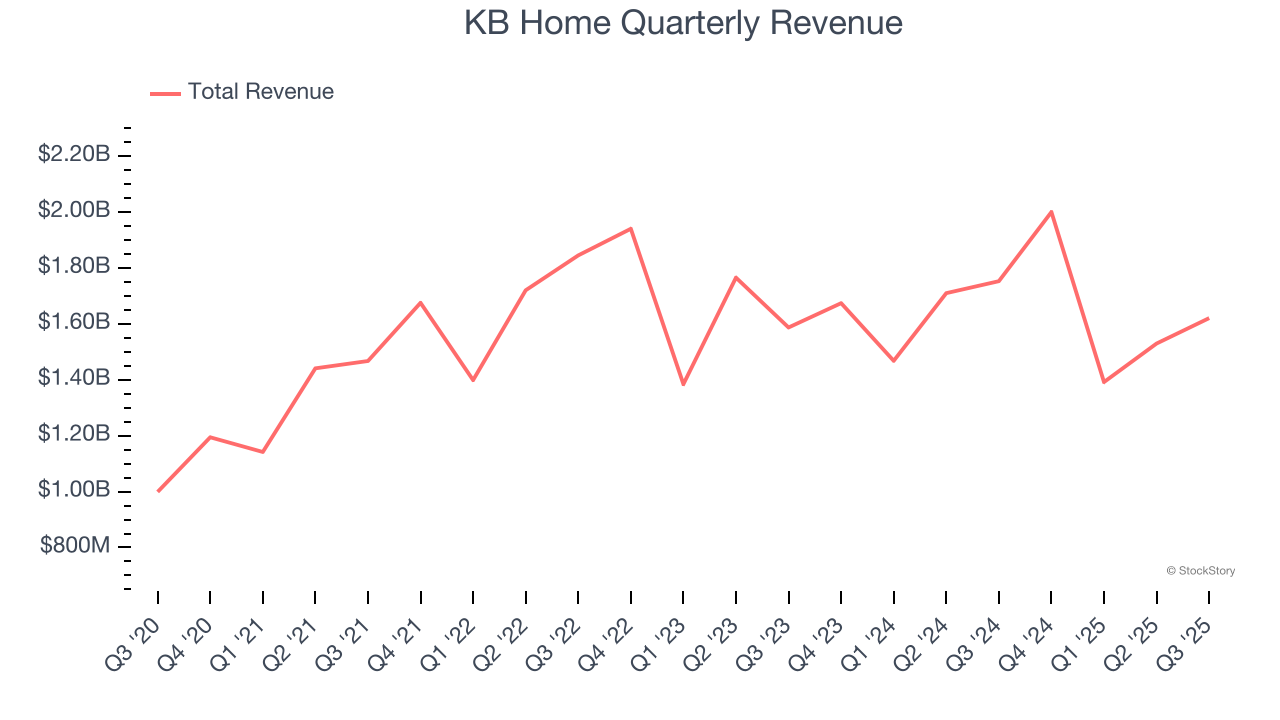
Long-term growth is the most important, but within industrials, a half-decade historical view may miss new industry trends or demand cycles. KB Home’s recent performance marks a sharp pivot from its five-year trend as its revenue has shown annualized declines of 1% over the last two years. 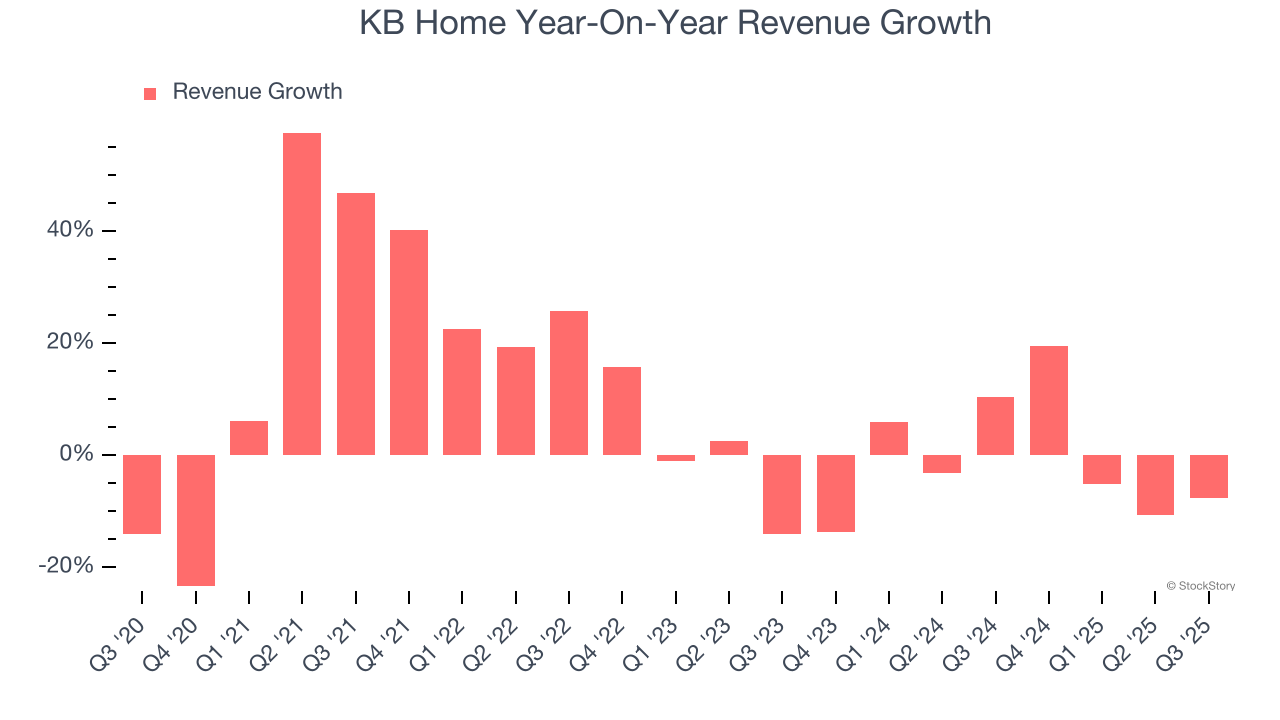
We can dig further into the company’s revenue dynamics by analyzing its backlog, or the value of its outstanding orders that have not yet been executed or delivered. KB Home’s backlog reached $1.99 billion in the latest quarter and averaged 20.4% year-on-year declines over the last two years. Because this number is lower than its revenue growth, we can see the company hasn’t secured enough new orders to maintain its growth rate in the future. 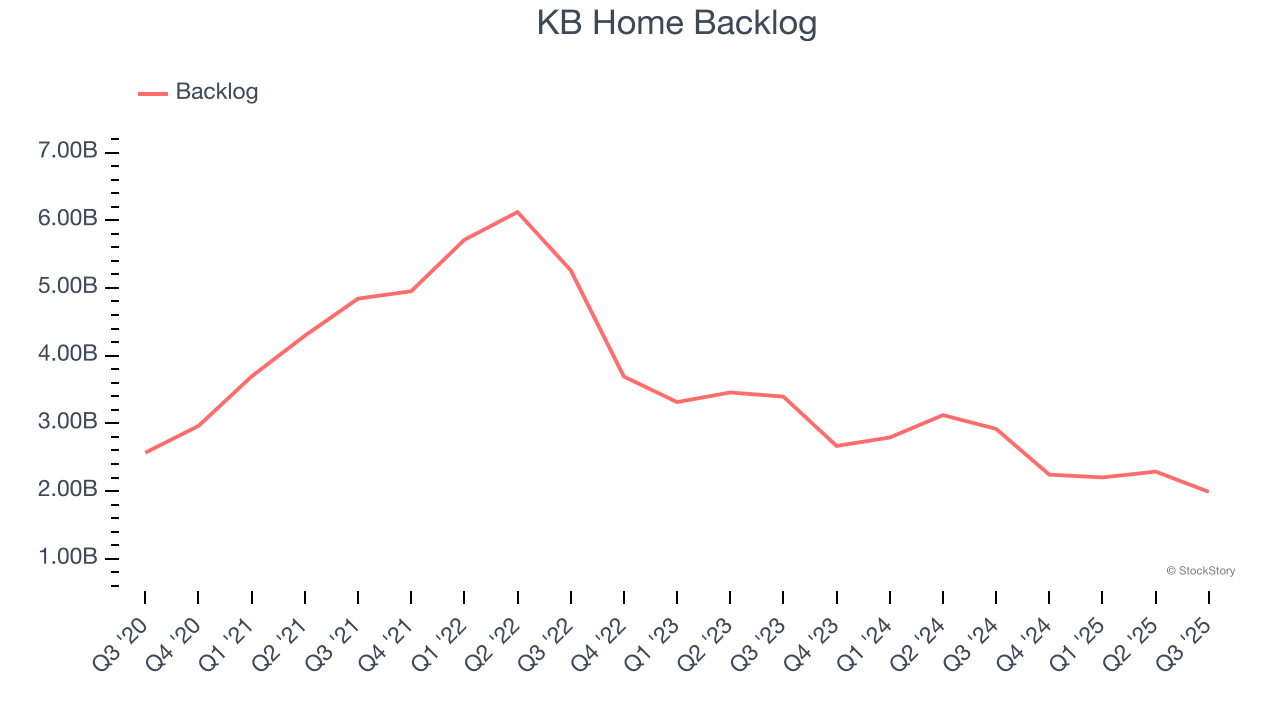
This quarter, KB Home’s revenue fell by 7.5% year on year to $1.62 billion but beat Wall Street’s estimates by 1.2%.
Looking ahead, sell-side analysts expect revenue to decline by 8.5% over the next 12 months, a deceleration versus the last two years. This projection doesn't excite us and implies its products and services will see some demand headwinds.
Here at StockStory, we certainly understand the potential of thematic investing. Diverse winners from Microsoft (MSFT) to Alphabet (GOOG), Coca-Cola (KO) to Monster Beverage (MNST) could all have been identified as promising growth stories with a megatrend driving the growth. So, in that spirit, we’ve identified a relatively under-the-radar profitable growth stock benefiting from the rise of AI, available to you FREE via this link.
Operating Margin
Operating margin is a key measure of profitability. Think of it as net income - the bottom line - excluding the impact of taxes and interest on debt, which are less connected to business fundamentals.
KB Home has been an efficient company over the last five years. It was one of the more profitable businesses in the industrials sector, boasting an average operating margin of 11.9%. This result was particularly impressive because of its low gross margin, which is mostly a factor of what it sells and takes huge shifts to move meaningfully. Companies have more control over their operating margins, and it’s a show of well-managed operations if they’re high when gross margins are low.
Looking at the trend in its profitability, KB Home’s operating margin decreased by 1.3 percentage points over the last five years. This raises questions about the company’s expense base because its revenue growth should have given it leverage on its fixed costs, resulting in better economies of scale and profitability.
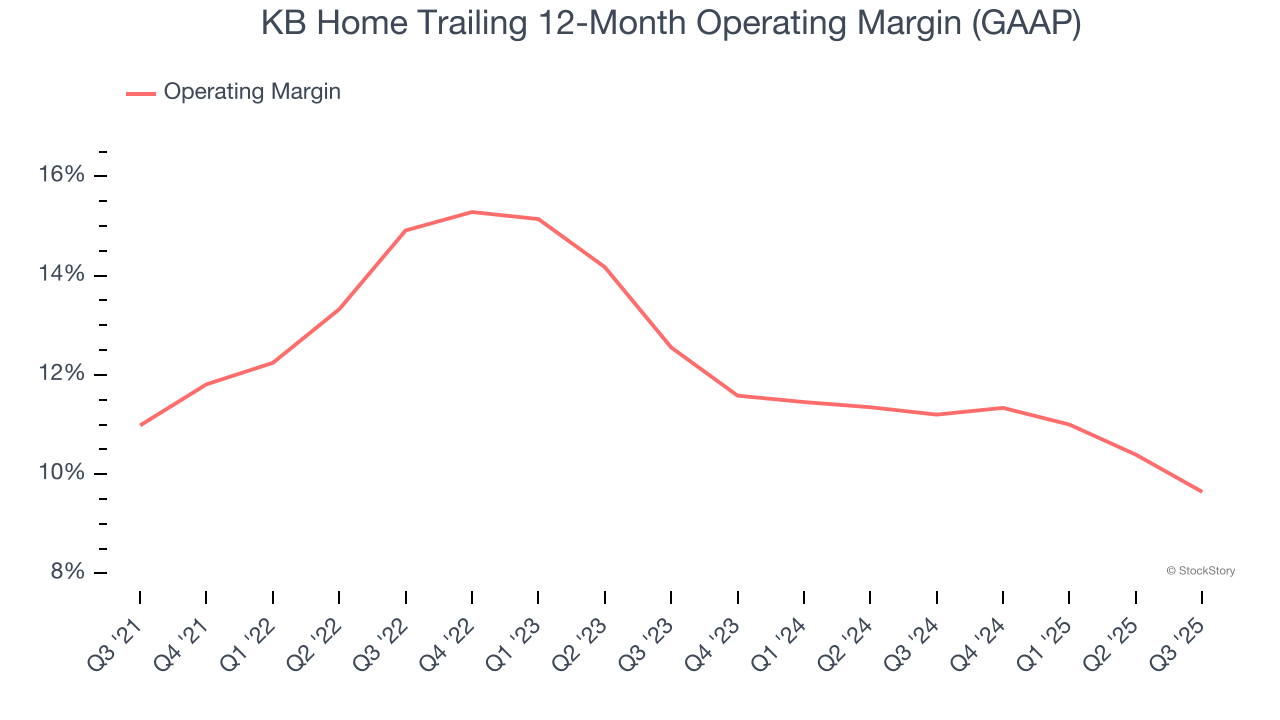
This quarter, KB Home generated an operating margin profit margin of 8.1%, down 3 percentage points year on year. Since KB Home’s operating margin decreased more than its gross margin, we can assume it was less efficient because expenses such as marketing, R&D, and administrative overhead increased.
Earnings Per Share
Revenue trends explain a company’s historical growth, but the long-term change in earnings per share (EPS) points to the profitability of that growth – for example, a company could inflate its sales through excessive spending on advertising and promotions.
KB Home’s EPS grew at a spectacular 16.6% compounded annual growth rate over the last five years, higher than its 7.5% annualized revenue growth. However, this alone doesn’t tell us much about its business quality because its operating margin didn’t improve.
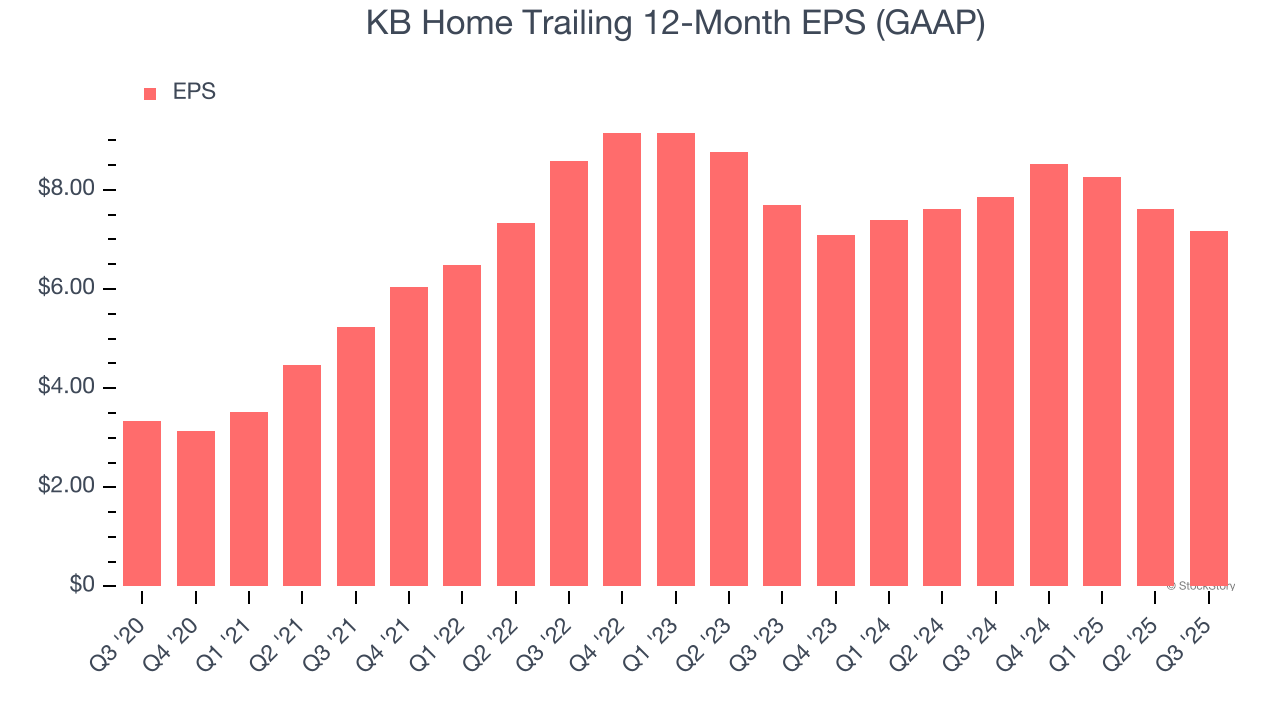
We can take a deeper look into KB Home’s earnings to better understand the drivers of its performance. A five-year view shows that KB Home has repurchased its stock, shrinking its share count by 28%. This tells us its EPS outperformed its revenue not because of increased operational efficiency but financial engineering, as buybacks boost per share earnings. 
Like with revenue, we analyze EPS over a shorter period to see if we are missing a change in the business.
For KB Home, its two-year annual EPS declines of 3.6% mark a reversal from its (seemingly) healthy five-year trend. We hope KB Home can return to earnings growth in the future.
In Q3, KB Home reported EPS of $1.61, down from $2.05 in the same quarter last year. Despite falling year on year, this print beat analysts’ estimates by 6.9%. Over the next 12 months, Wall Street expects KB Home’s full-year EPS of $7.16 to shrink by 16.2%.
Key Takeaways from KB Home’s Q3 Results
It was good to see KB Home narrowly top analysts’ revenue expectations this quarter. We were also glad its EPS outperformed Wall Street’s estimates. On the other hand, its backlog fell short of Wall Street’s estimates and the company lowered its full-year revenue guidance, which is never a good sign. Overall, this was a weaker quarter. The stock remained flat at $61.86 immediately after reporting.
KB Home may have had a tough quarter, but does that actually create an opportunity to invest right now? The latest quarter does matter, but not nearly as much as longer-term fundamentals and valuation, when deciding if the stock is a buy. We cover that in our actionable full research report which you can read here, it’s free.
More News
View More




Recent Quotes
View More
Quotes delayed at least 20 minutes.
By accessing this page, you agree to the Privacy Policy and Terms Of Service.